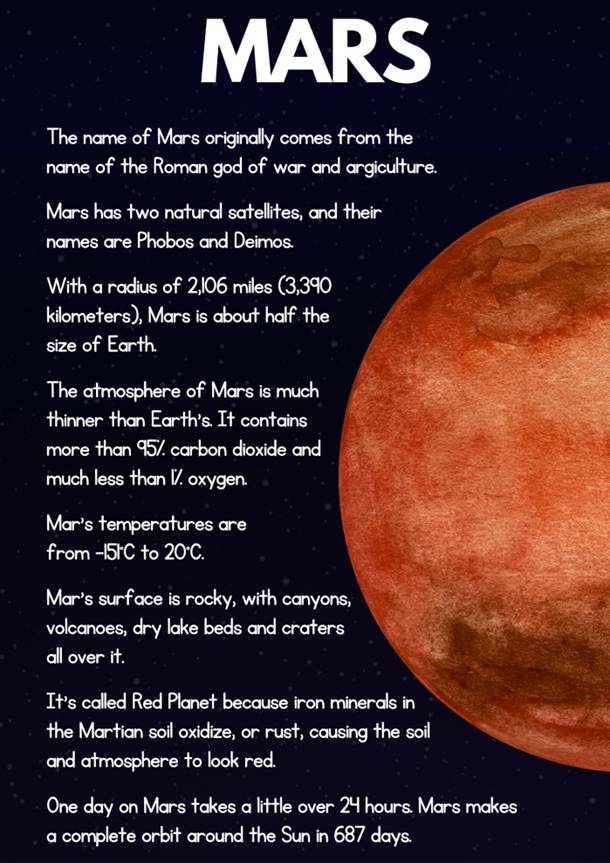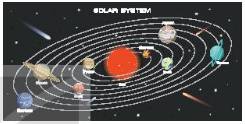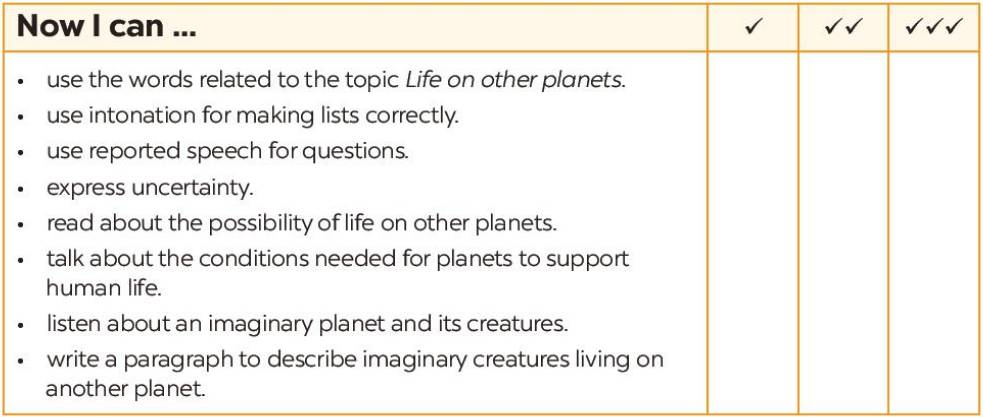
Hãy nhập câu hỏi của bạn vào đây, nếu là tài khoản VIP, bạn sẽ được ưu tiên trả lời.


1. moons
2. rocky surfaces
3. objects
4. huge
5. rings
1. Many of the planets in our solar system have moons.
(Nhiều hành tinh trong hệ mặt trời của chúng ta có mặt trăng.)
2. The four inner planets are quite small and have rocky surface.
(4 hành tinh ở trong nhỏ hơn và có bề mặt đá gồ ghề.)
3. The asteroid belt has millions of rocky objects.
(Vành đai của tiểu hành tinh có hàng triệu vật thể bằng đá.)
4. The outer planets are huge and mostly made up of gas.
(Những hành tinh bên ngoài lớn và chủ yêu được tạo thành từ khí.)
5. These outer planets all have thick layers of clouds and rings around them.
(Những hành tinh bên ngoài này có những lớp mây dày và những vành đai xung quanh chúng.)

The Solar System is made up of all the planets that orbit our Sun. In addition to planets, the Solar System also consists of moons, comets, asteroids, minor planets, dust and gas. The inner solar system contains the Sun, Mercury, Venus, Earth and Mars. The main asteroid belt lies between the orbits of Mars and Jupiter. The planets of the outer solar system are Jupiter, Saturn, Uranus and Neptune (Pluto is now classified as a dwarf planet).
Everything in the Solar System orbits or revolves around the Sun. The Sun contains around 98% of all the material in the Solar System. The larger an object is, the more gravity it has. Because the Sun is so large, its powerful gravity attracts all the other objects in the Solar System towards it. At the same time, these objects, which are moving very rapidly, try to fly away from the Sun, outward into the emptiness of outer space.
The result of the planets trying to fly away, at the same time that the Sun is trying to pull them inward is that they become trapped half-way in between. Balanced between flying towards the Sun and escaping into space, they spend eternity orbiting around their parent star.
The Planets orbit in the same direction (counter-clockwise looking down from above the Sun’s North Pole); all but Venus, Uranus and Pluto also rotate in that same sense. Mercury has the fastest elliptical orbit,
48 km per second. It has the shortest revolution at 88 days. Pluto has an orbital speed of 5 km per second. It takes 248 years for Pluto to make one complete revolution.
The Solar System has eight planets, arranged in order of distance from closest to farthest from the sun: Mercury, Venus, Earth, Mars, Jupiter, Saturn, Uranus, Neptune. Mercury is the planet closest to the sun and it's also the smallest, only slightly larger than Earth's moon. It's a planet in the solar system named after the Roman gods. The 2nd Planet in the Solar System – Venus is the second planet from the Sun, Venus is the twin size of Earth. The surface has many different mountains and volcanoes.It is name after the roman god mercury , who was the fast flying messenger of the god. Earth is the third planet closest to the solar system, and the only planet with life. The fourth planet closest to the sun is Mars and the second smallest planet in the solar system. It is named after the roman god of war. The 5th planet in the Solar System – Jupiter is a gas giant. This is the largest planet in the system our sun. This is a planet named after the god of thunder and lightning. 6th Planet in the Solar System – Saturn is the sixth planet from the Sun, Saturn is best known for its rings. It is name after roman god of agriculture. Uranus - the seventh planet in the Solar System has extremely strange and interesting features. Uranus is the first planet in the Solar System to be discovered using only a telescope. 8th planet in the Solar System – Neptune is the eighth planet from the sun, Neptune is about the same size as Uranus. It is name after the roman god of the sea

B. Choose the correct answers.
1. What is the passage about?
A. Planets in our solar System
B. The difference between Earth and other planets
C. Space exploration to find habitable planets
D. NASA’s missions to explore the outer planets
2. The Kepler space telescope is looking for__________
A. new planets in our galaxy
B. life on other planets
C. liquid water on other planets
D. Earth-sized planets in the solar System
3. Kepler has found five planets that__________.
A. has water and air
B. are similar to Earth
C. are not too far away from the Earth
D. are not in our solar System
4. The Kepler team predict that they will need__________ to find an Earth-like planet.
A. three years and possibly longer
B. as much as three years
C. no more than three years
D. approximately three years
5. What are the primary factors that make a planet habitable?
A. Liquid water and living things
B. Size and distance from the Sun
C. Hot temperature and weak gravity
D. Strong gravity and too much air
6. How much does the Kepler mission cost?
A. Exactly $600 million
B. About $600 million
C. More than $600 million
D. Less than $600 million
7. Which of the following statements is NOT true?
A. The planet can support life if it has water and air.
B. A very small planet will not have enough air.
C. Earth is four times as big as Neptune.
D. Kepler mission is scheduled to end in 2013.

gạch chân đáp án đúng
1 the members of Kim's family (travel/travels)to American
2 a flag from every country (was/were)painted in the book
3 all the reports on the meeting (is/are) on the desk
4 all the planets in the solar system (orbit/orbits) the sun
5 the light from the sun (take/takes) 8 minutes to reach Earth
6 the news (was/were) extremely terrified
7 the leader,along with three his colleagues and two supporters(is/are) discussing on the problem
8 each of the cars in the street (is/are)new

Đáp án: A
Giải thích: cấu trúc there are + Ns: có…
Dịch: Có rất nhiều hành tinh trong dải ngân hà.

Giúp mik vs ạk😭
Mik có lm rùi mà chỉ sợ sai nên nhờ mọi người kiểm tra lại giúp mik vs ạk
Cảm ơn!!❤️
Sửa lỗi sai trong các câu sau
How much books are there on the table?
much ⇒ many
How many students is there in your school?
is ⇒ are
How many sugar do you have?
many ⇒ much
How much money do you mom have?
do ⇒ does
How many floors does your house has?
has ⇒ have
How much Coffee are there in the jug?
are ⇒ is
How many children does your parents have?
does ⇒ do
How much water are there in the swimming pool?
are ⇒ is
How much friends do you have?
much ⇒ many
How many peoples are there in your house?
peoples ⇒ people

Tham khảo
Hello everyone, today I will talk about Mars, the 4th planet in our solar system. The name of Mars originally comes from the name of the Roman god of war and agriculture. It may not seem like these two things go together, but they do. Mars protected those who fought for their communities and stayed home to raise crops for food. Mars has two natural satellites, and their names are Phobos and Deimos. With a radius of 2,106 miles (3,390 kilometers), Mars is about half the size of Earth. The atmosphere of Mars is much thinner than Earth's. It contains more than 95% carbon dioxide and much less than 1% oxygen. Mar's temperatures are from -151°C to 20°C. Mars is colder than Earth. If you were to stand on the surface of Mars on the equator at noon, it would feel like spring at your feet and winter at your head. Mar's surface is rocky, with canyons, volcanoes, dry lake beds and craters all over it. It's called Red Planet because iron minerals in the Martian soil oxidize, or rust, causing the soil and atmosphere to look red. One day on Mars takes a little over 24 hours. Mars makes a complete orbit around the Sun in 687 days. Thanks for listening.


eight
tru Mat troi ra la cs ́ thi fai .